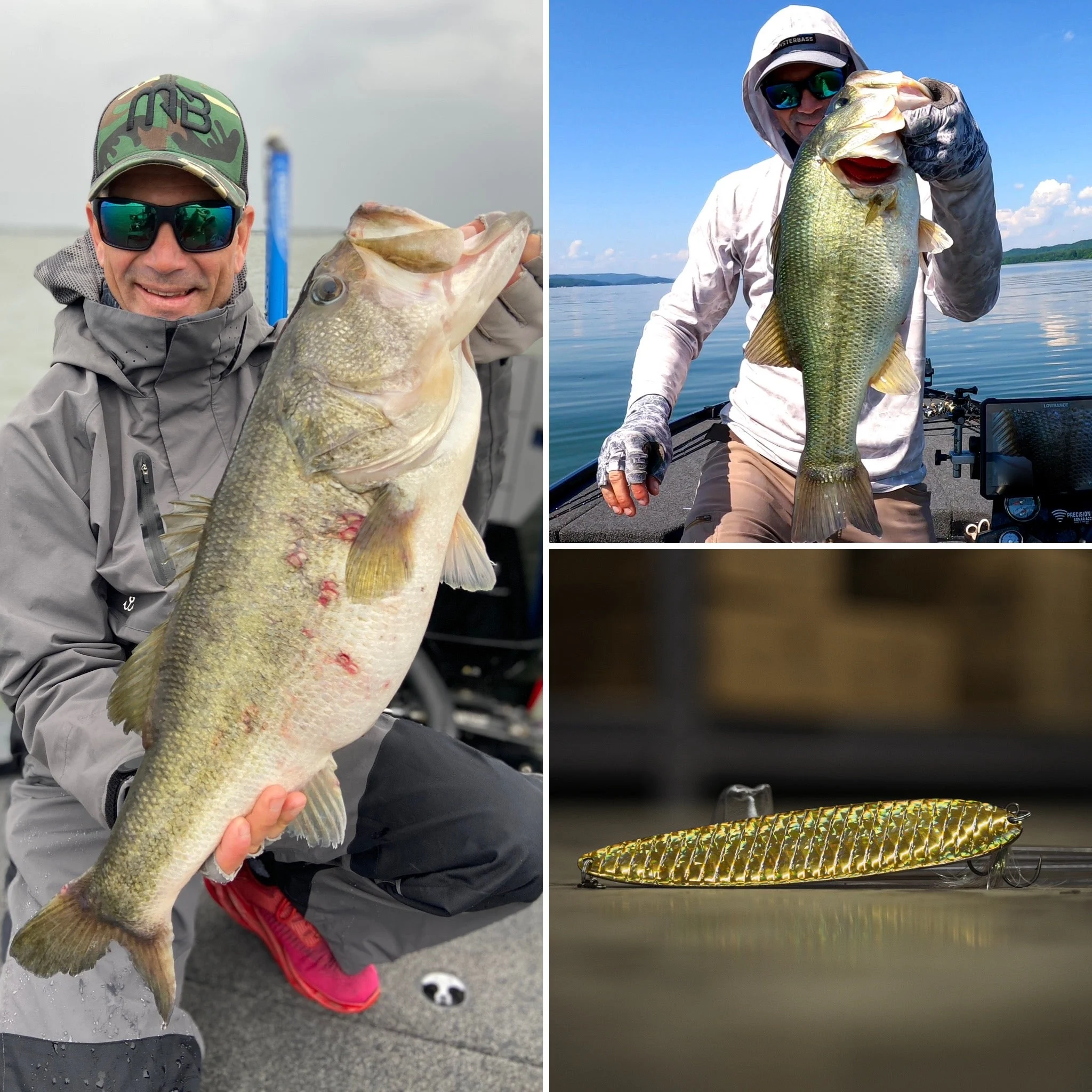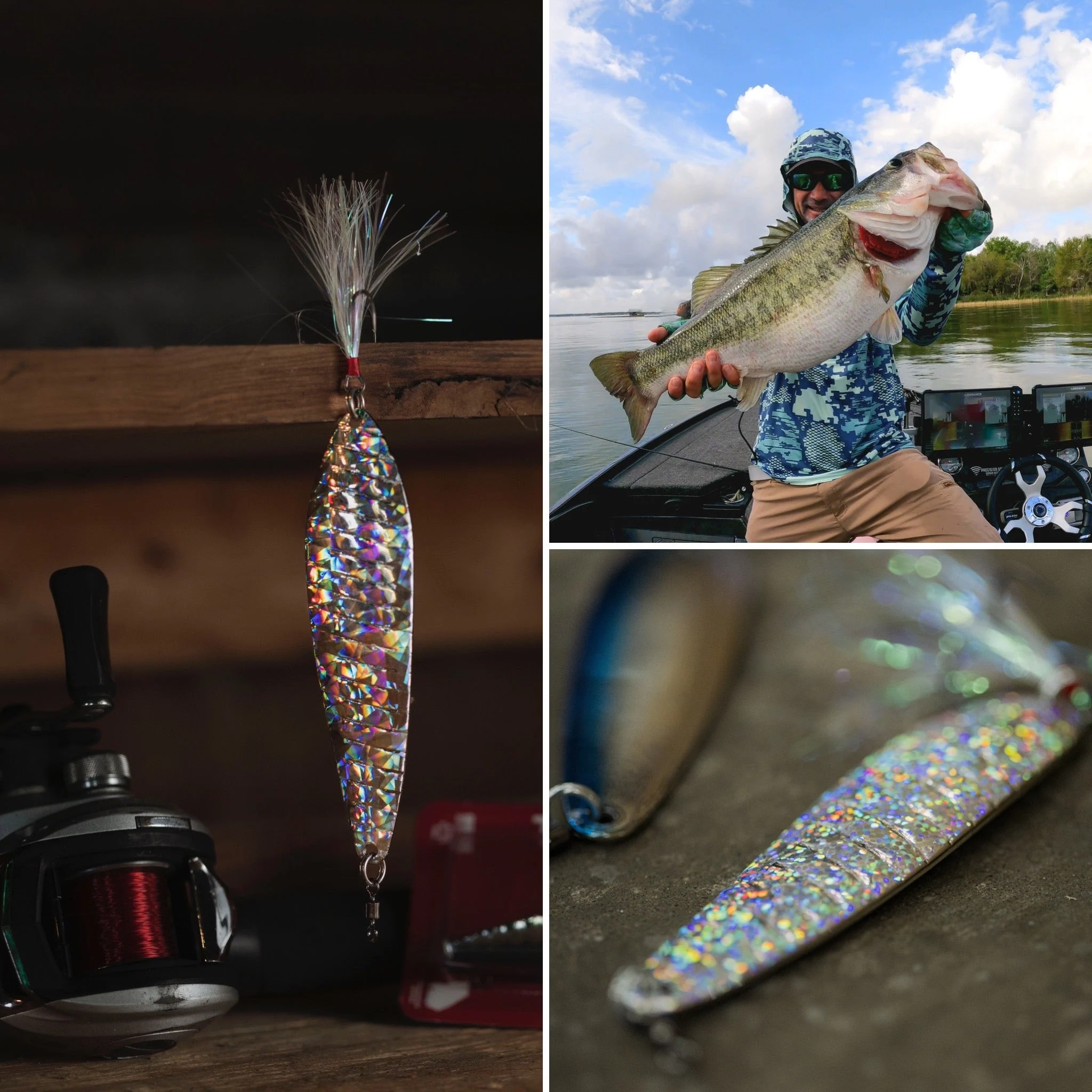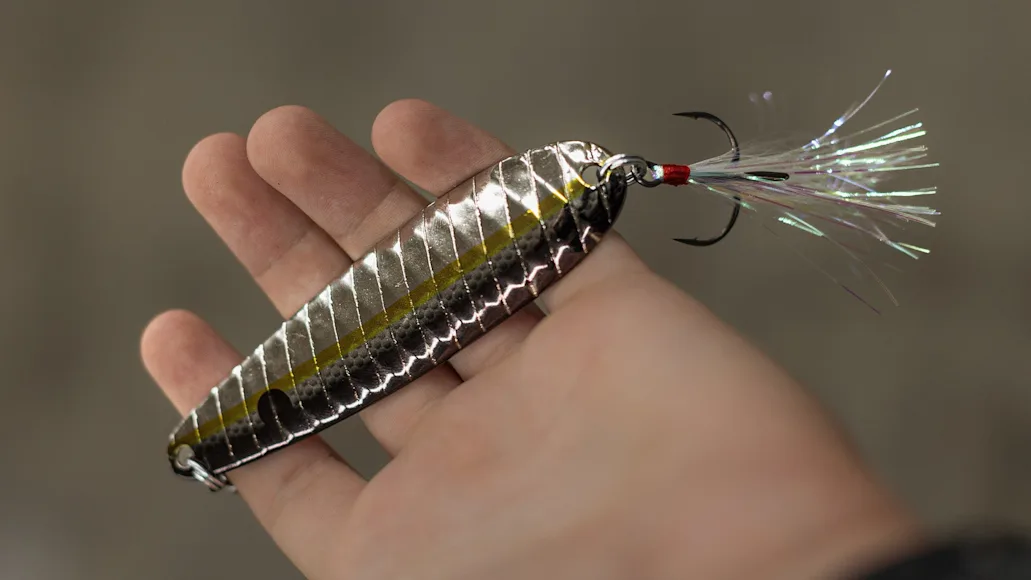Flutter spoons are great bass baits for summertime fishing
, spotted, and even some smallmouth bass become susceptible to these chunks of metal as fish move offshore and look for a reprieve in cooler, deeper waters. Here, schools of bass will group up on isolated cover like brushpiles, ledges, and points, looking to ambush prey. And flutter spoons are a great way to feed them what they think they want.
We sat down with YouTuber and bass fishing expert Mikey Meisenheimer
—better known as Mikey Blazz on YouTube—to discuss the ins and outs of the flutter spoon bite. He’s been hauling in big bass and filming himself doing so for decades—and knows a thing or two about fishing these big metal baits. So we asked him to walk us through how to fish a flutter spoon in different conditions, times of year, and water depths.

From left counterclockwise: Meisenheimer with a giant bass; a gold flutter spoon, Meisenheimer with another big bass. Mikey Meisenheimer/Landon Beaty
How to Fish a Flutter Spoon
To fish a flutter spoon, cast it out, let it fall to the bottom, and then rip up with a quick upward jerk of the rod. Then, turn the reel handle a few rotations to take up some slack while allowing the bait to fall back to the bottom on a semi-slack line. Snatch it up again when your line goes slack, indicating the bait has reached the bottom.
“I’ll have the reel in one hand and the rod butt in my other,” says Meisenheimer. “Then I’ll do a snapping retrieve from about 45 to 70 degrees.” Making an accurate cast is also crucial to effectively fish a flutter spoon. “Don’t cast too far either, or it will slice, just like a bad golf slice,” he says. “The spoon can blow off target in the slightest amount of wind and alter your retrieve.”
Meisenheimer also stresses the importance of following the bait back down after you rip it off the bottom. This allows you to detect baits on the fall and be ready to rip it again once it reaches the bottom.
“Many guys will just drop their rod and wait for the bait to go back to the bottom,” says Meisenheimer. “You want to pop it up, track it down, let it hit the bottom, and pop it up again. Just go through that process until you’ve retrieved it all the way back to the boat.” On the fall, you’ll often feel or see a subtle bite thanks to the consistent contact with the bait that he talks about.
A strong hookset may be necessary in situations where you’re fishing really deep or in a lot of current, as both can cause a large bow to develop in your line. But usually, a firm upward hookset will connect well with the fish. It’s what happens during the fight that matters most. Because of the sheer weight of these spoons, the bass can gain leverage on you quickly and throw the lures to free themselves if they’re allowed to jump.
“You get two or three jumps on these fish,” says Meisenheimer. “The best way to land a fish is to drag them in as much as possible and not let them jump.”
Most flutter spoons are fairly large compared to other bass lures, some weighing as much as 4.5 ounces and measuring 9 inches in length. However, a great example of a standard casting spoon is the 5-inch Nichols Lake Fork Flutter Spoon.
This bait weighs 1 and 1/8 ounces and is one of Meisenheimer’s favorites.
Why Fish a Flutter Spoon
Flutter spoons are great for offshore fishing in the summer because they offer a big meal and can be used to cover a wide range of the water column. Meisenheimer has found this increasingly evident as he’s paired the technique with forward-facing sonar technology.
“I’ll throw a flutter spoon in 15 feet of water and jerk it up to somewhere between 7 and 9 feet,” says Meisenheimer. “I never realized how much of the water column I was covering until I got forward-facing sonar.”
These spoons also cover a lot of water horizontally since they give off massive amounts of flash and a serious thump as they are snatched up and allowed to flutter back down to the bottom. All of this makes flutter spoons fantastic for processing deep water quickly.
When to Fish a Flutter Spoon
Meisenheimer recommends tying on a flutter spoon as soon as the bass wind down their spawning process
and begin to move offshore. Bass start grouping up offshore as early as late April, and the bite can linger in places all the way into the fall.
“When we hit May, flutter spoons become part of the rotation,” says Meisenheimer. “I like fishing them when it’s sunny out because they are reflective and can create reactive bites.” Though Meisenheimer prefers to fish these baits on sunny days, he’ll also throw them with a decent amount of cloud cover. In his opinion, there really isn’t a bad time to fish a flutter spoon, as long as you have at least one of two things: a little bit of wind or a little bit of current.
The current positions and activates the fish, making them easier to target and more aggressive. The chop on the water created by wind helps to break up the hard flash of the spoon, making it a more realistic presentation compared to the flat and bright glow of one of these baits in dead calm conditions. The ideal depth to fish a flutter spoon is 12 to 25 feet of water, but you can go deeper if you want. You don’t want to fish a flutter spoon in less than 10 feet of water.
You can also catch bass on a flutter spoon in various water clarities. However, the clearer, the better. This isn’t a technique you want to use in “chocolate milk,” but they’ll bite these baits in dingier water, too. Meisenheimer has caught bass on spoons in one to two feet of visibility. He says that green-stained water is better than muddy water.

From left clockwise: A traditional silver flutter spoon, Meisenheimer with a big largemouth, another average sized flutter spoon. Mikey Meisenheimer/Landon Beaty
Flutter Spoon Color Choices
Chrome is the standard color for traditional spoons, but there are dozens of different options on the market. Some spoons are painted to match various baitfish, like sand bass, yellow bass, gizzard shad, blueback herring, golden shiner, and more.
“You have to go a little flat or yellow or gold when you get cloud cover, says Meisenheimer. “A darker, more silhouette-oriented color performs better on cloudy days, and flash is better on sunnier days.”There are also spoons made with textured patterns designed to mimic the scales of baitfish. These patterns are often described as hammered, pounded, or shattered glass.
“If it is dead flat, that’s when I’m getting out that pounded glass to break up the light refraction,” Meisenheimer says. Nichols Lures has a color called Gizzard Scale that’s pounded glass with a darker look. I like that for lower light conditions, maybe a little dirtier water because it has a yellow stripe in it.”
Gear Recommendations
Rod: 7′ 5″ to 7′ 9″ medium heavy casting rod
Line: 17 to 20-pound fluorocarbon
Reel: Shimano SLX A 150 7.2:1
Lure: Nichols Lake Fork Flutter Spoon
: 5 inch 1 1/8 ounce size
Lure: Shattered Glass Silver Scale/Sand Bass/Gizzard Scale
Conclusion: Catch More Bass on Big Metal Baits
If you can find fish deeper than 10 feet between May and October, a flutter spoon is worth a try. These baits generate a lot of flash and a unique thump, allowing you to cover expansive areas quickly. And they are excellent big-bite producers. There are dozens of size and color combinations to choose from with flutter spoons, but keeping it fairly simple is the best method when getting started.
Pick a couple of colors so you’ll have something to throw in various conditions. When fishing, lob the bait out, follow it down to the bottom on a semi-slack line, and then pop it back up as soon as it hits the bottom. Repeat this process until you get your bait in or get a bite. Do this long enough in the right areas, and you’re bound to catch a big one.


